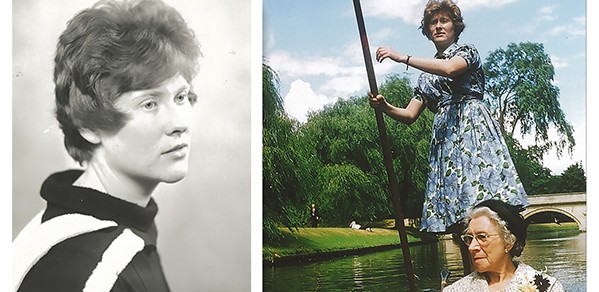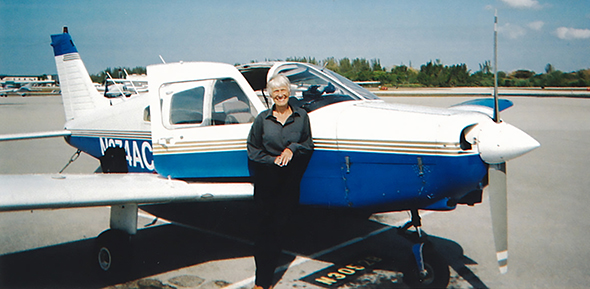
Alumna Ann Roberts (née Wilkinson) shares her memories of being an engineering student at Cambridge during the 1950s.
After Cambridge Finals in 1959, I went straight into my first job with Bristol Aircraft at the princely sum of £600 per year.
Alumna Ann Roberts
“I’m sure it will entertain, amuse, and/or horrify some of your present students,” she says, “So here it goes…”
I matriculated at Newnham College in 1956. Originally reading Natural Sciences, I switched to Aeronautical Engineering for the last year. As preparation for the year’s course, I was required to complete a basic practical course in either welding or milling; I chose the latter as I could burn myself simply by boiling an egg!
I joined the Apprentice Training School at the nearby company of A. V. Roe. At the time, it was a flourishing local aircraft manufacturer. I was regarded with some suspicion as the company had never had a female apprentice before, but once I was accepted, all the tutors and fellow apprentices were so helpful that I had no trouble completing the course successfully.
All the qualifying students on the course were treated to a flight on an AVRO plane – except me. But, as so often encountered back then, the apologetic disclaimer was that the flights were ‘not insured for women’. I did, however, get a large box of chocolates and the good wishes of the entire class.
My presence at the Engineering Lab came as quite a shock to both staff and students. By the end of my first day in the lab (located at the time on Lensfield Road), I must have been asked over 100 times whether or not I was a student. I had to be extra careful to uphold the future reputation of all female students, such as dressing neatly and femininely! We had all known of a female student in the past who had ridden a 1000cc motorbike, been a demon-fast bowler on the Newnham cricket team, and had terrified all lesser females who met her!
Several staff members asked what I was doing there, and all without exception expressed their pleasure at having a female student. One student, however, was heard to say, “Damn, we shall have to start shaving now”, but after the initial shock wore off, I was met with nothing but encouragement and support from staff and fellow students.
At the time, resources in the labs were scarce. For example, when students wished to borrow books to take home in the holidays, the popular texts were limited and one had to provide a list of requests to overstretched librarians, who then allocated the few copies they had. These books were to be collected from the main library table on the last day of term. The piles of books were tied with string in named heaps. I remember I had difficulty finding mine, simply because it was right in the middle, tied with a huge bow of red ribbon, and decorated with tinsel and mistletoe!

Ann learned to fly in this plane. This photo was taken at the airport in Naples, Florida, in the early 2000s. Credit: Ann Roberts.
My father was an engineer and was full of encouragement for me. He was delighted when I continued to pursue the same career. After Cambridge Finals in 1959, I went straight into my first job with Bristol Aircraft at the princely sum of £600 per year (we did not have to search for jobs, they came to us in those days).
I was lucky enough to have a very successful career with Bristol Aircraft. I spent nearly five years working for the company in their research department. I worked on the destructive phenomenon of Flutter which, at the time, was causing much concern. I then moved on to studying airflow in general. I worked with a small but brilliant team of four and actually published a paper for the Aeronautical Research Council with my immediate boss J. G. Wright, titled Airflow over Ogival Wings.
My pay rapidly increased. This was after it was discovered that the male assistant I soon employed was being paid considerably more than I was. It was a great time however, and I enjoyed working with such clever people, as well as the chance to work at other famous laboratories across the UK, including the Royal Aircraft Establishment at Farnborough, where I found myself seated once in the front row of the stands for Farnborough Air Show. Soon after I got married, I became pregnant, and my job was terminated because of the then ‘company policy’ – ‘working mothers’ were a bad risk.
After becoming a mother, I tried to return to work, but virtually the entire aeronautical industry in the UK had either died or moved to America. My career took a change of direction. I got involved in the possibilities of ‘centre pivot’ irrigation agriculture. In around 1970, I was lucky enough to be a guest at a meeting of the International Conference on Irrigation and Drainage (ICID), in Bulgaria, and the following year, in Hungary, as a contributor to the next ICID meeting, this time as an official delegate. For this meeting I put together a report on ‘Irrigation and Drainage in the United States’ which was also published.
I received a commemorative Gold Medal, presented to me by the Egyptian Chief Engineer of the Aswan Dam in Egypt. I felt very special to receive this precious medal from the ICID to mark the completion of the Dam (the charming gentleman wanted me to have something special to celebrate that I was the first woman not only to make an impression on the conference delegates, but also to present a paper). I ended my working life in the research labs of a Finnish company that was developing the use of enzymes in the growing of food crops. I relocated to the USA in 2001.
I loved my time at the Department of Engineering. Even the occasional disapproval from my days there armoured me for the prejudice and resentment I would later encounter in the real world. Every time I open my copy of the Department of Engineering News, I’m comforted and impressed to see how today’s young women have made their mark in the engineering world and continue to do so. I’m filled with admiration for them.
Thank you Cambridge for allowing me such a marvellous beginning to a very happy and long life.

